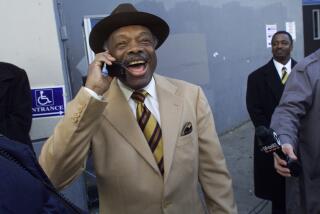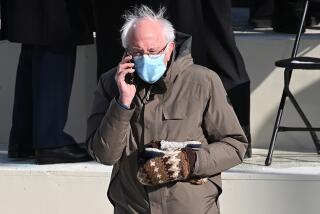Collector Buttons Up for Life and Politics
- Share via
Historians recall presidential candidate William Jennings Bryan for his fiery oratory against the gold standard. But Buena Park resident Dennis Doran remembers the 1896 campaign for a much lesser-known reason.
It was during that race between Democrat Bryan and Republican William McKinley that partisans first started sporting political buttons on their lapels.
By Franklin D. Roosevelt’s third run for office in 1940, manufacturers were pouring a quarter of a million tons of tin alloy to support such slogans as “Better a Third-Termer Than a Third-Rater.”
Doran, who owns 7,000 buttons reminiscent of various categories of American life, does not have a Bryan pin. His oldest is a tiny red-painted tin button from 1920 advocating Warren G. Harding’s merits for the Oval Office.
This month, Doran is displaying the pin from that and scores of other races in display cases at the Buena Park Library, 7150 La Palma Ave.
His collection could command a respectable price, but the 45-year-old admissions and records technician at Cypress College said that is beside the point.
“I don’t collect them to make a profit,” he said. “I collect them because I get a kick out of sharing them.”
Doran first realized the power of the button in the 1960s, when he wore a button supporting activist Eldridge Cleaver in the Michigan home of his parents.
“Talk about the roof coming off the house,” he recalled, rolling his eyes.
Then he took to wearing anti-war buttons to annoy his Navy superiors.
“I got conscious of what buttons could do in the Vietnam era,” he said, “although, in the ‘60s, I wasn’t conscious of much.”
As his collection grew, stored carefully in shoe boxes, he expanded his categories, adding buttons advertising movies, products, sports, even religion.
The buttons at the library until the first of the year are mostly political, though.
Library visitors will note the humor of Wendell L. Willkie, who ran against Roosevelt in 1940. His consultants designed a little button spelling “Will-” with a little key hanging suspended from it.
And few could beat Barry M. Goldwater’s campaign team for ingenuity. They created jewelry and made beverage cans that professed to be a can of “gold water--the right drink for the conservative taste.”
The political button went into decline after the 1960 Nixon-Kennedy race, when politicians began to discover the power of the television commercial, Doran said.
They survived after that, Doran said, though on a smaller scale. The buttons produced now are not meant to last, he said, and typically are of inexpensive paper that cannot be preserved.
More to Read
Get the L.A. Times Politics newsletter
Deeply reported insights into legislation, politics and policy from Sacramento, Washington and beyond. In your inbox twice per week.
You may occasionally receive promotional content from the Los Angeles Times.









